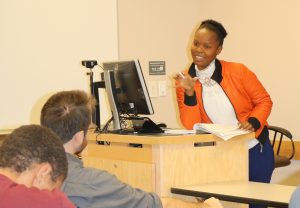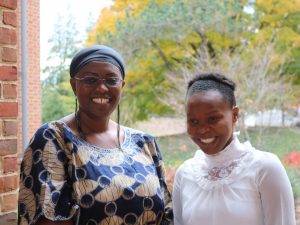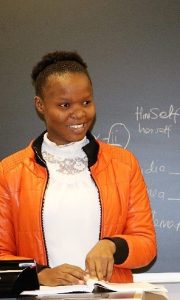Author: Hope Fitzgerald
Test tour hosting
Flipgrid Sample
Step 5 Activities (letter identification)
Let’s practice some letter identification! CLICK on each example of the letter you find.
This advert comes from the popular Jordanian series الجار قبل الدار about the misadventures of an American living in Amman, and the Jordanians who tolerate him.
الجار قبل الدار is a commonly used phrase to mean, “the neighbor before the house” ie it’s more important to choose good neighbors than a good house.
H5P Sample: Course Presentation (Hokkaido, Japan)
H5P sample created by Tessa Short, UVA Curry School graduate student
H5P Example: ESL Phrasal Verbs
H5P sample created by Tessa Short, UVA Curry School graduate student
H5P Example: Interactive ESL grammar, vocabulary, and listening
H5P sample created by Tessa Short, UVA Curry School graduate student UVA welcomes Fulbright Swahili TA Edith Kachia
In August 2018, the Swahili language program in the Department of African American and African studies welcomed Edith Mwevezi Kachia as a Fulbright Foreign Language Teaching Assistant for the 2018-19 academic year.

Kachia, a native of Kenya, brings a wealth of cultural insights, linguistic knowledge, and enthusiasm to her new life on grounds.
Kachia currently teaches beginning Swahili language under the direction of Anne Rotich, Assistant Professor of African American and African Studies, who spearheaded the effort to bring an FLTA to the UVA Swahili program. Alongside teaching, she leads Swahili conversation tables, and has developed cultural events related to Swahili cultures, including a Swahili film night near the end of the semester.
It Took a Village
Rotich, who also heads the UVA Swahili program, worked throughout Spring 2018 to request a Swahili-speaking assistant via the Fulbright FLTA program. The

FLTA program, a long-standing initiative of the US Department of State, places international teaching assistants at hundreds of US universities annually. With the support of The Carter G. Woodson Institute for African American & African Studies’ Director, Deborah McDowell, and Associate Dean Francesca Fiorani, Rotich submitted a successful application in Spring 2018. Kachia is only the second FLTA to be placed at UVA (the first was an Urdu language FLTA, in 2013).
Of the Fulbright FLTA application process, Rotich says “Arranging for Edith to come to UVA took a whole village, to plan and ultimately bring her here!” That village–from Carter Woodson, the International Studies Office, and other partners across grounds–have supported Kachia in getting set up with office space, locating housing, and settling in to Charlottesville. Though the application and supervisory responsibilities are considerable, the benefits outweigh the costs, and Rotich is considering seeking FLTA support in the future.
Expanding Opportunities for Meaningful Learning
The opportunity for increased interaction with a native speaking educator—particularly of a less-commonly taught language such as Swahili—is a key benefit of the FLTA program. FLTA participants hold degrees in English, Education, and related fields, and often have significant work experience as educators. For students of languages with relatively few textbooks and resources, having a trained instructor to learn from can make a major difference. With Kachia’s presence, the Swahili program is able to both deepen student learning, through increased language contact, and expand it, by introducing more students to Swahili cultures across grounds. Kachia recently gave presented on contemporary Kenyan music in Rotich’s Swahili Cultures course—a course that might not have been offered without Kachia’s addition to the teaching team.
Kachia is especially interested in creating discussion around cultural perspectives and practices, and often brings up cultural issues in class. As an example of a cultural perspective that may be new to UVA students, she notes that she refers to her father’s brother not as “uncle” but as “baba” (“father”) because “For us, you understand that you are a child of your community, not just of your parents.” Introducing such perspectives, and asking students to engage with them, allows Kachia to create space for deeper intercultural understanding and communication.
Studying at UVA: New Courses and Opportunities
Kachia’s teaching and learning experiences in the US extend well beyond her Swahili classroom, as she adjusts to life in Charlottesville and to being both an instructor and a student in the US educational system. Fulbright FLTAs joining US universities are required to enroll in two university courses per semester, so Kachia opted for one course in Women’s Literature, and another in Black Queer Culture. “Black queer culture is a course that is not taught back in Kenya, because it is controversial. Therefore, I wanted to learn more,” she says. With a smile she recalls a meaningful experience in the course, when Professor Timothy Griffiths asked students to consider the song that described them best. “Immediately, a song started in my mind: Girl Power by Cheetah Girls!”
Fulbright FLTAs joining US universities are required to enroll in two university courses per semester, so Kachia opted for one course in Women’s Literature, and another in Black Queer Culture. “Black queer culture is a course that is not taught back in Kenya, because it is controversial. Therefore, I wanted to learn more,” she says. With a smile she recalls a meaningful experience in the course, when Professor Timothy Griffiths asked students to consider the song that described them best. “Immediately, a song started in my mind: Girl Power by Cheetah Girls!”
Eager to get the most of her time at UVA, Kachia says “During my year at UVA, I am looking forward to learning and participating in many American cultural experiences and opportunities that may come my way. I look forward to sharing cultural experiences with my Swahili students, meeting new friends, learning more about things that I love, and trying new things.”
–Hope Fitzgerald, Language Commons
Workshop: VR for Language Learning
On 10/16/18, faculty from the Chinese, German, Japanese, Spanish, and Arabic language programs, as well as the Center for A merican English Language and Culture, explored the possibilities for using Virtual Reality (VR) in language courses. The workshop, led by the Language Commons’ Hope Fitzgerald and Jason Bennett from A&S Learning Design & Technology, examined ways in which this emerging technology is being used in language classrooms around the US.
merican English Language and Culture, explored the possibilities for using Virtual Reality (VR) in language courses. The workshop, led by the Language Commons’ Hope Fitzgerald and Jason Bennett from A&S Learning Design & Technology, examined ways in which this emerging technology is being used in language classrooms around the US.
Equipped with VR headsets, and with their phones tucked into Google Cardboard devices to access VR content and 360˚ videos, workshop attendees were able to experience a more immersive, engaging, and motivating learning experience compared to 2-dimensional video. Possible uses for VR in language learning could include virtual ethnographic explorations, tours of cultural landmarks, and immersive storytelling. Students can also develop their own 360˚ content to share in class, making VR a fertile area for creative, authentic learning. VR is gaining popularity across grounds, and the University continues to encourage active learning by making VR headsets available for drop-in and class use in the Wilson Interactive Media Studio, Language Commons, Gilmer STEM Commons, and the UVA libraries.
Using media to supplement your language learning
Ever “accidentally” distract yourself from your language study by binging on some Netflix or mindlessly scrolling through social media? We’ve all been there, but those seemingly malignant distractions can actually be beneficial to your language learning! Here are a few tips for making the most of those distractions:
Social Media: Join a Group/Event Page
Look through pictures and captions (pictures can help you to understand captions, since they provide visual context), read posts, and pay attention to comments. As you read, focus on what you DO understand, or on words you notice REPEATING over and over in posts. Try to get yourself used to focusing on what you do understand, and letting go of the rest, unless it seems truly interesting or vital to you. If you’re a beginner in the language, consider that just reading the TITLES of various groups (and then reading them aloud) is going to be good reading & pronunciation practice for you.
Do something active: post in the group—even just a few words! Try to engage someone in an exchange of info. Or, construct posts that you’d want to make. Write them down and practice them aloud, without reading them, as if you were responding in oral conversation.
Benefits of searching for & following pages on social media:
-
- you discover some current, popular topics relevant to native speakers
- you get to follow meaningful linguistic exchanges back and forth among native speakers.
- you’re likely to see relevant vocabulary repeated over and over again, since people are discussing the same topic. You might see useful and repeated expressions of thanks, excitement, anger, agreement, etc.
- The language used on Facebook can be colloquial and conversational, which should be useful for you! Just keep in mind, it might contain errors (autocorrect is NOT just a problem in English)
How to find a group:
- You might search for a “humans of…” group, a news outlet, or a social cause you’re already interested in.
- It’s usually best to do your search in the target language (one caveat: “humans of…” groups often are titled in English regardless!)
- If you’re a beginner in the language, consider that just reading the TITLES of various groups is going to be great reading practice for you!
 https://www.pexels.com/photo/apps-blur-button-close-up-267350/
https://www.pexels.com/photo/apps-blur-button-close-up-267350/
Netflix for learning vocab in context
We spend a good chunk of time trying to memorize vocabulary items, and they’re often coming at us only in writing, and often without a context. While it’s useful to create your own written context (for example, trying to put a word you’re learning into a meaningful sentence), you really need to see, hear, and experience vocabulary being used in authentic contexts.
This is especially true for listening, which is the most neglected skill in language learning! Your ears and brain need to practice picking the word out of a stream of sound, linking the sound to its meaning, and understanding how the surrounding words (and grammar) function together to make that word meaningful.
- Which leads us to…captioned and subtitled movies & TV!
Subtitles (in English) or Captions (in the target language) can help you notice words and phrases being used, so that you can rewind and listen to exactly how the words are being used. Next time you’re watching a show in your target language on Netflix, turn on the captions in the target language, if available. Read them as you’re enjoying the show. Pause and rewind when you want to focus on how a particular word is used. First, can you actually hear the word being used? Next, what words surround it? Are there prepositions involved? What about tone, facial expression, or gesture? Now, try to use the word in a similar context (create a similar sentence, use it aloud, try it out on a native speaker) to solidify your understanding!
 Photo by freestocks.org from Pexels
Photo by freestocks.org from Pexels


